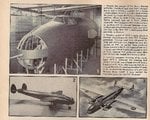You're right. I can't find any designation for the circular proposal, but the idea appears to have been started by a letter written in early 1935 by Captain Harry A. Johnson to Major General Benjamin Foulis recommending a heavily-armed super fighter capable of destroying bombers. The new plane would have the new designation "FM" for "fighter, multi-place".
Both Bell and Lockheed were issued $25,000 contracts to submit preliminary designs with a deadline of March 15, 1936. Bell won the competition by four-tenths of a point, 72 to 71.6 out of a possible 100. The Airacuda was set ahead by its twin cannons to the Lockheed's one. The Lockheed aircraft's designation was XPB-3 and later XFM-2.
Interestingly, the designer of the Airacuda for Bell was a former project manager at Lockheed.
Another humorous note - before the war, Bell visited the Messerschmitt factory in Germany and questioned what a long line of prototype Me-109s were for - to which Willi Messerchmitt quipped, "What is the Airacuda for?"
Both Bell and Lockheed were issued $25,000 contracts to submit preliminary designs with a deadline of March 15, 1936. Bell won the competition by four-tenths of a point, 72 to 71.6 out of a possible 100. The Airacuda was set ahead by its twin cannons to the Lockheed's one. The Lockheed aircraft's designation was XPB-3 and later XFM-2.
Interestingly, the designer of the Airacuda for Bell was a former project manager at Lockheed.
Another humorous note - before the war, Bell visited the Messerschmitt factory in Germany and questioned what a long line of prototype Me-109s were for - to which Willi Messerchmitt quipped, "What is the Airacuda for?"

